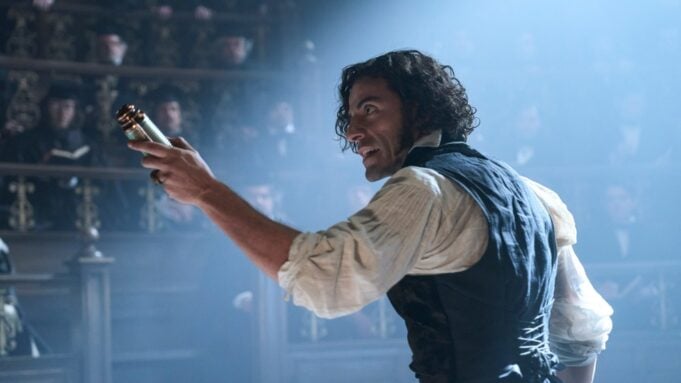More than once, incensed characters accuse the mad doctor of being the true “monster” in Guillermo del Toro’s “Frankenstein” — not to be confused with Mary Shelley’s “Frankenstein,” even though this latest adaptation hews closer to the author’s intentions than any previous version put to screen.
What is a film director if not a man who plays God, and who among that circle identifies more with monsters than Mr. del Toro, the visionary Mexican director who started his career with “Cronos” (a “Frankenstein”-adjacent dark fairy tale) and earned an Oscar for the respect he paid outsiders in “The Shape of Water”?
Alas, that same empathetic approach feels less revolutionary in “Frankenstein,” since most versions of Shelley’s story feel for the brute, as opposed to his creator (played less like a scientist than a tortured artist by a long-haired Oscar Isaac). Boris Karloff embodied him as a tragic figure, crouched by the lake with the little girl, naive to the danger he poses for others. Now we get Jacob Elordi, looking like an emo jock or a wounded soldier, which is partly true, as he’s been reconstructed from the corpses of several.
As del Toro sees it, Frankenstein’s pitiful creation has been cursed with life, cannot be killed (even bullets don’t stop him) and must face the same existential crisis that confronts us all. No one asks to be born, but once thrust into the world, we must each find our purpose. Early volumes of “Frankenstein” featured a quotation from John Milton’s “Paradise Lost”: “Did I request thee, Maker, from my clay / To mould me man?” In this version, the blind old man (David Bradley) encourages his intellectually curious visitor to seek wisdom from that same tome.
In principle, del Toro has gone back to the book for his two-and-a-half-hour magnum opus, which cost more than “Titanic” and still looks like it was made for TV (as much as that pains me to say). Technically, “Frankenstein” was made for Netflix, and though the streamer will give it whatever theatrical run it’s contractually obliged to honor, the visual effects weren’t rendered for big-screen consumption. Alexandre Desplat’s baroque score, on the other hand, makes up for it in grandeur.
Rest assured, del Toro remains a cinematic master, and every costume, set and prop was crafted with formidable imagination and a daunting attention to detail. But those elements may be better suited to consumption via the bulky coffee-table book Netflix will undoubtedly release for its awards push, as opposed to the fisheye presentation afforded by DP Dan Laustsen’s large-format cameras. Gorgeous as it may be, the entire film feels as if we’re watching through a peephole. Strangely, Laustsen’s wide-angle lenses make “Frankenstein” feel smaller, when the point was conceivably to squeeze more image into every frame.
Del Toro once entertained the notion of splitting the story into two movies, each told from a different perspective — first Frankenstein’s, followed by his creation’s revisionist version of events — but he ultimately decided to present them one after the other. This mid-movie handoff dilutes the shock of how articulate the wretch proves in del Toro’s telling (the creature could barely speak in James Whale’s original Universal monster movie).
Love Film & TV?
Get your daily dose of everything happening in music, film and TV in Australia and abroad.
In keeping with Shelley’s epistolary novel, the movie opens in the arctic, with a ship trapped in ice. A monstrous figure passes by sled, though its silhouette defies what audiences surely hold in their heads. This lurching form appears wrapped in rags, hiding its face till much later in the film, as it forces its way aboard in pursuit of Dr. Frankenstein, the man who willed it to life, but failed to consider what comes next.
One wonders, is faithfulness to Shelley a good thing? And is that even what audiences want from the “Pan’s Labyrinth” director, who brings all of the strengths and weaknesses of his artistry to the project he was presumably put on this earth to make? Where the 1931 film ran a tight 71 minutes, del Toro takes more than twice that time.
The man has a brilliant mind when it comes to identifying the deeper themes he wants to explore, but they can sometimes feel simplistic when presented in his films. Unlike “Pinocchio” — which dealt with similar ideas of man creating life without the involvement of woman (or anything approaching human connection) — longer doesn’t necessarily mean deeper. Once again, del Toro shows an unflinching attitude to violence, thrusting our faces in with the scalpels and bone saws (the sound may actually be more traumatizing). But he’s strangely stunted when it comes to the depiction of sexuality.
That proves inadvertently comical in a scene where Isaac, as Victor Frankenstein, sits in the tub, shot from nearly the same angle del Toro presented Bradley Cooper bathing in “Nightmare Alley.” Bubbles obscure the important bits. Then the doctor stands up, and we may as well be watching “Austin Powers,” as del Toro blocks the scene using random objects to block his genitals.
Why is del Toro so coy about nudity in a film where the same character, Dr. Frankenstein, is shown graphically slicing away at cadavers a few minutes later? The same applies to his studly homunculus, wrapped in a loincloth that effectively desexualizes the statue-like figure (who might otherwise be the sexiest version we’ve seen since Andy Warhol’s “Flesh for Frankenstein”).
Is the “monster” still frightening if he poses no sexual threat? And what is the abstract attraction future sister-in-law Elizabeth (Mia Goth) feels toward him, if lust is off the table? These don’t seem to be questions that del Toro has considered, while others — including Shelley’s central concerns around scientific “ambition,” her word for the unchecked experimentation that leads man to play God — seem of relatively little interest.
Perhaps he feels that “Jurassic Park” warning (that just because man can doesn’t mean he should) has been sufficiently dissected in other horror movies. Why resurrect that here, when del Toro can explore different realms of psychology, such as the scars that fathers leave on their sons and the way those wounds are visited on future generations?
The movie’s most villainous character is neither Frankenstein nor his creation, but Victor’s domineering dad, Leopold (Charles Dance). Lauren Collins plays his more understanding mother, Claire, whose premature demise — giving birth to his brother, William (Felix Kammerer) — may have inspired young Victor’s experiments in conquering death. No one throws a more elegant funeral than del Toro, to the extent that the sight of Claire’s face in the casket becomes the single most impactful visual in a film with countless to choose from.
Meanwhile, her devastated young son (Christian Convery) comes across like a future serial killer, ultimately landing a patron for his schemes in Christoph Waltz’s Harlander, a character who exits at precisely the moment his brain might have come in handy. It’s he who finds the abandoned water tower that serves as Frankenstein’s lab (modeled after a similar Victorian structure in New Romney, Kent, but made to appear even more Mordor-worthy). Though the interiors are impressive, they may be too much so, to the point of distraction.
Exteriors are unconvincing, which undercuts the illusion del Toro is trying to achieve, such that a scene with CG wolves looks too fake to be upsetting. “Frankenstein” takes a turn toward the profound about halfway through, when Elordi bursts onto the ship and assumes the narration for the benefit of the Scandinavian captain (Lars Mikkelsen). It’s moving to hear him recount how he escaped his burning tower, twisting free of his chains — a slave elevated to Marvel superhero.
From the beginning, the creature displays extraordinary strength and the power to withstand gunfire, and yet those very qualities make him feel more like Wolverine than a monster to modern eyes. Two centuries after Shelley found a fictional cure for mortality, the species seems no closer to reversing death. Dr. Frankenstein doesn’t scream, “It’s alive! … Now I know what it feels like to be God!” in del Toro’s telling. Instead, we get characters who warn, “Only monsters play God,” and a creature who craves companionship, faced with the impossible task of living.
From Variety US































